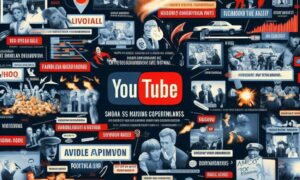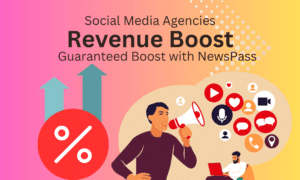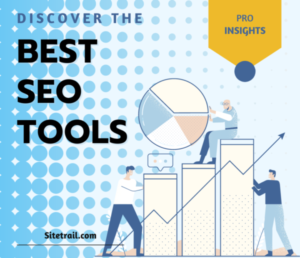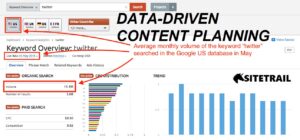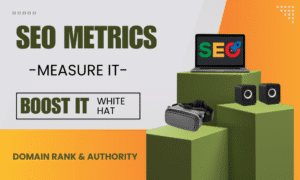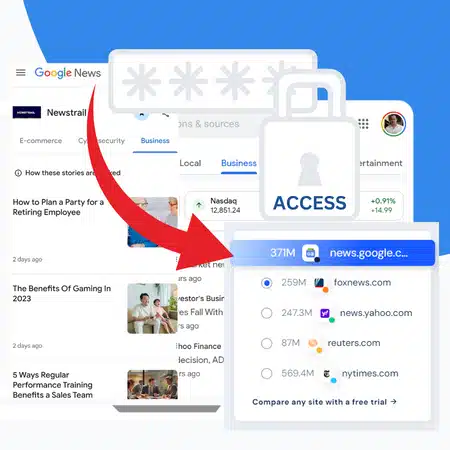Do you know which search engines are the most popular for? This really matters. In today’s fast-paced online environment, search engines hold the keys to visibility, engagement, and business growth. This guide offers a deep dive into the top search engines, shedding light on their strengths, challenges, and unique features.
Suggested tools:
- See how the unlimited access pass from Sitetrail can help you boost online visibility and referral traffic.
- Also take a closer look at the best SEO tools we listed.
Now whether you’re a budding entrepreneur or a seasoned marketer, understanding these platforms can be your game-changer. Let’s unlock the secrets of search engine optimization and digital marketing success together
Google: The Digital Giant
Ah, Google. The digital titan that has become synonymous with the very act of searching online. Its prominence in the digital space is unquestionable.
Pros & Cons
The Good Stuff:
The sheer volume of users. If your content ranks well on Google, you’re talking about exposure to a ginormous user base. This means potential traffic, leads, and conversions that can drive business growth.
The Challenges
With great power comes great competition. EVERYONE wants a slice of that Google pie. Organic search here is fiercely competitive. And yes, paid search, with those AdWords, can drain your pockets faster than you’d think. Moreover, there’s a noticeable shift in how Google presents search results. The introduction of features like snippets means users get their answers without necessarily clicking on your link. The goalposts are always moving, and it’s essential to stay updated with Google’s ever-evolving algorithms.
Optimization Tips for Google
Quality Content is King
Focus on creating high-quality, relevant content. This is non-negotiable.
User Experience
Ensure your site is mobile-friendly, has fast load times, and offers an intuitive user experience.
Backlinks
Building authentic backlinks from reputable sites can significantly boost your ranking.
Use Relevant Keywords
But avoid keyword stuffing. Natural integration is the name of the game.
Stay Updated
Google’s algorithms change. Regularly review and adjust your strategy accordingly.
YouTube: The Video Revolution
Remember the days of waiting for a video to buffer? Those are long gone, thanks in part to platforms like YouTube. With its staggering user statistics, YouTube is more than just a place for funny cat videos; it’s a pivotal marketing platform.
Pros & Cons
The Good Stuff
Just think about it – over a billion hours of video being watched daily! If your content hits the right note, it’s like striking digital gold. The potential reach is simply mind-boggling.
The Challenges
But here’s the rub: with such a vast audience comes a deluge of content creators. Every minute, a staggering 500 hours of video content is uploaded. Standing out in that crowded field? It’s not a walk in the park. Additionally, while advertising here offers great potential reach, it falls under Google’s advertising umbrella, meaning it can be quite costly.
Optimization Tips for YouTube:
- Engaging Thumbnails: Your video’s thumbnail can make or break its click-through rate.
- Optimized Video Titles & Descriptions: Integrate keywords naturally to enhance discoverability.
- Consistent Posting: Just like any other platform, consistency can be your ticket to growing an audience.
- Engage with Your Community: Reply to comments, collaborate with other creators, and foster a sense of community.
- Use Analytics: YouTube provides a wealth of data. Dive deep into it to understand your audience and refine your strategy.
Amazon: The E-Commerce Behemoth
Ah, Amazon. Founded in 1995, this e-commerce powerhouse transformed the way we shop online. Jeff Bezos’s brainchild began as a humble online book store and quickly expanded its horizons. The staggering fact? Nearly half of all online shopping searches begin on Amazon, overshadowing even Google. With acquisitions like Whole Foods under its belt, it’s clear Amazon’s influence in the e-commerce domain will only rise.
Pros & Cons of Amazon
The Upside
The sheer magnitude of Amazon is its primary advantage. If you’re selling something, be it blue widgets or organic avocados, you want your products listed on Amazon. The platform is where users typically turn when they’re ready to purchase, making it a conversion goldmine.
The Hurdles
Every rose has its thorns. On Amazon, your product is directly pitted against competitors. Users can easily compare prices, features, and reviews, making it essential for your product to truly stand out. The platform’s focus on products makes it challenging to emphasize unique brand value. Moreover, gaining initial traction can be tough without reviews or sales to back you up. Also, while the platform offers Cost-Per-Click (CPC) promotional options, these can be a tad heavy on the pocket.
Optimization Tips for Amazon:
- Keyword Research: Ensure product titles, descriptions, and backend search terms are optimized with relevant keywords.
- Stellar Imagery: High-quality images can drastically improve click-through and conversion rates.
- Garner Reviews: Encourage satisfied customers to leave positive reviews. It significantly influences buying decisions.
- Stay Competitive: Regularly review your pricing strategy and ensure it aligns with the market.
- Monitor Performance: Use Amazon’s analytics tools to track performance and refine your strategy accordingly.
Facebook: Beyond Social Connections
Enter Facebook, the social media titan. Since opening its doors to the general public in 2006, Facebook’s growth has been nothing short of phenomenal. While it might not be the first platform that springs to mind when thinking of search engines, it handles over 2 billion searches a day! Couple that with its monthly user base of over 1.62 billion, and it’s clear why businesses are keen to advertise here.
Pros & Cons of Facebook
The Upside
Facebook’s primary allure lies in its massive user base. With such an audience, the platform offers unparalleled access to potential customers. Its advertising system, while centered around demographic data, allows businesses unparalleled flexibility, making it ideal for product launches or brand promotions.
The Hurdles
But here’s the catch – this vast user base doesn’t come cheap. Advertising on Facebook can be quite costly, especially for specific demographics. While Google Ads focuses on search intent, Facebook’s ad targeting hinges on demographics, potentially reducing relevancy.
Optimization Tips for Facebook:
- Engaging Content: Regularly post engaging content that resonates with your target audience.
- Ad Targeting: Fine-tune your ad targeting settings to ensure they align with your ideal customer profile.
- Engage with Your Audience: Interaction boosts your organic reach. Respond to comments, messages, and ensure you maintain an active online presence.
- A/B Testing: Experiment with different ad formats, visuals, and copy to determine what resonates best with your audience.
- Leverage Analytics: Facebook offers detailed analytics. Use this data to refine and hone your digital strategy continually.
Bing (Now Known as Microsoft Bing)
Bing sprouted as Microsoft’s counterpart to Google back in 2009. At its inception, it had a modest 8.4% of the search market share. However, by powering Yahoo search and later adding AOL to their portfolio, they’ve upped their game and positioned themselves closer to a 25.7% market share, when you account for all Microsoft products and properties. In 2020, Bing underwent a rebranding transformation and came to be known as Microsoft Bing.
Advantages & Challenges of Microsoft Bing
Bing’s Unique Selling Points
Bing, or shall we say, Microsoft Bing, has steadily carved its niche in the search market, particularly in areas like the U.S. and U.K. When it comes to organic searches, Bing’s algorithms, although progressing, don’t match the sophistication of Google’s. But that’s a silver lining! Their relative simplicity makes Bing more predictable and user-friendly for optimization, giving a competitive advantage to those who master its ins and outs.
The Flip Side
On the advertising end, Microsoft Bing might not have the bells and whistles of Google. With lower traffic, one could argue that Bing isn’t a heavyweight. However, the counterargument is its cost-per-click (CPC) which is considerably lower. But a word of caution: Bing’s interpretation of close variants can sometimes be a curveball, leading to unwarranted costs.
Molding Your Bing Strategy
Transferring your Google Ads campaigns to Microsoft Ads isn’t a silver bullet. While it streamlines the process, it’s essential to fine-tune each campaign to align with Bing’s user demographics, CPC, and other variables.
Baidu: The Chinese Search Giant
Established in 2000, Baidu stands tall as China’s top search engine, boasting a whopping 69.55% market share. In a nation where Google garners a mere 3.76% share, Baidu is the titan, handling around 3.3 billion searches daily.
Baidu’s Strengths & Weaknesses
The Baidu Advantage
The sheer volume of the Chinese market makes Baidu a lucrative platform. But one needs to remember, winning in China is a different ball game, thanks to its unique cultural, linguistic, and digital dynamics.
The Challenges
While Baidu offers a gateway to a massive audience, it’s confined mainly to China. For businesses trying to tap into this market from the outside, there’s a steep learning curve. You can’t just rely on Google Translate; a native touch is indispensable. Also, even though Baidu’s search algorithms might seem less intricate than Google’s, setting up campaigns can be a tad more challenging for foreign businesses.
Fine-Tuning Your Baidu Approach
To make an impact on Baidu, businesses should consider partnering with native experts who understand the cultural and marketing nuances of the Chinese audience.
Yandex: Russia’s Search Engine
Yandex, originating as an indexer for patents, came into existence in the early ’90s. By 1997, Yandex.ru had made its mark. The search engine took a giant leap in 2011 with an IPO worth $1.3 billion on the New York Stock Exchange. As of now, Yandex processes approximately 42.35% of Russia’s total searches.
Yandex’s Pros & Hurdles
The Yandex Edge
Yandex’s appeal lies in its ease of use and optimization, primarily because it doesn’t boast the complex algorithms seen in Google. This often means fewer competitors to wrestle with, both in organic and paid search realms.
Potential Roadblocks
Yandex has a strong local focus, which means its algorithms weigh geolocation more heavily. For international businesses, this could be a hurdle. On the upside, Yandex’s advertising platform generally offers a lower cost-per-click compared to the giants like Google and Facebook.
Crafting a Yandex Game Plan
Businesses aiming to make their mark on Yandex should be mindful of its geolocation emphasis and consider strategies that align with the preferences of the local Russian audience.
We Can Help You
Mastering the art of visibility can be a game-changer for your brand or business. While this guide offers a solid foundation, every situation is unique. If you ever feel overwhelmed or uncertain about the next steps, don’t hesitate to reach out. Collaborating with experts can provide the tailored insights and strategies that make all the difference.

